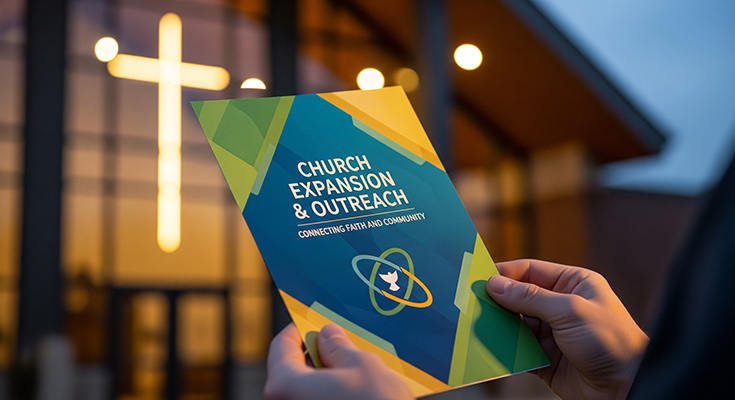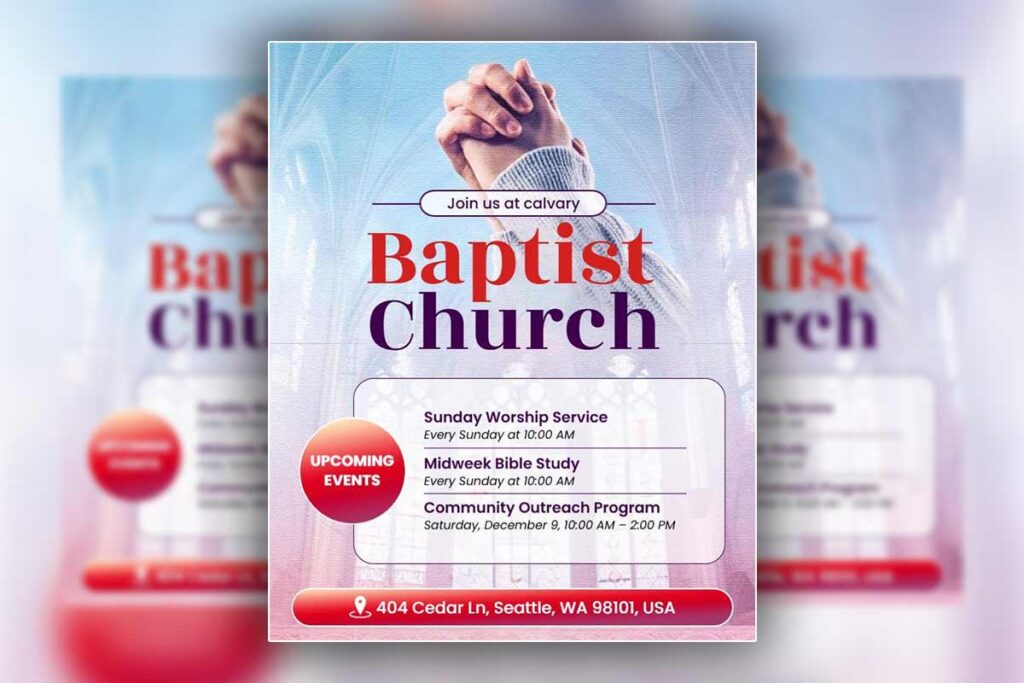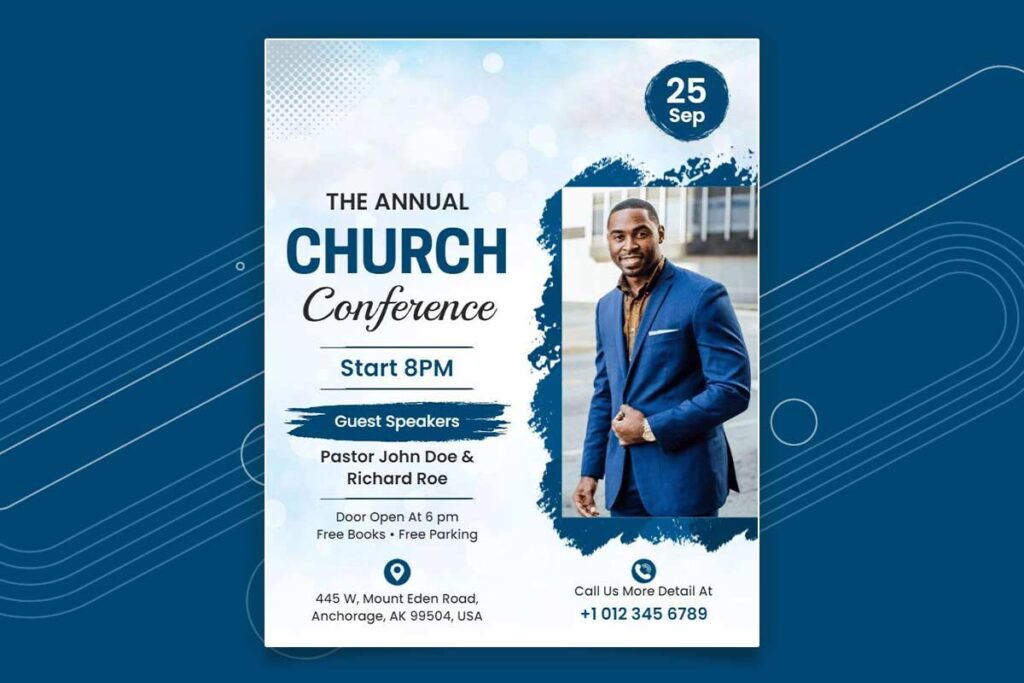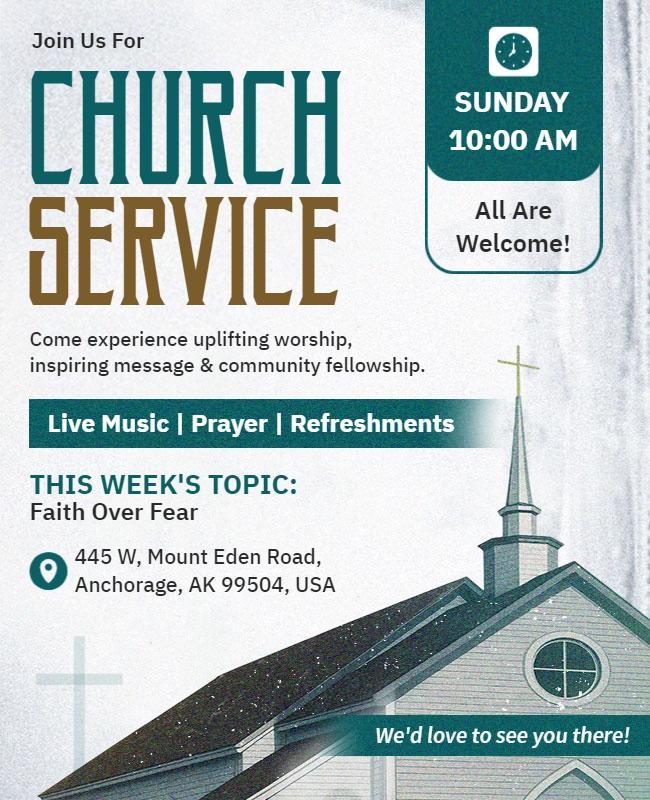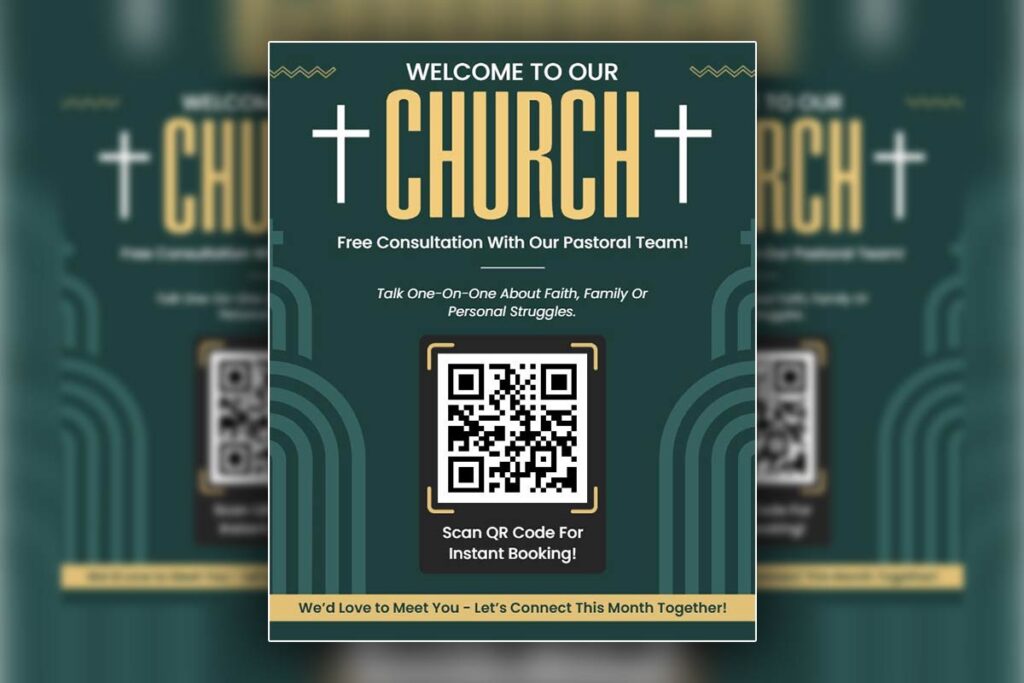Marketing consultants struggle with territory expansion because traditional referral networks leave significant gaps in new denominational markets where their expertise remains unknown. Church expansion flyers provide cost-effective introduction tools that penetrate untapped religious networks and geographic territories where word-of-mouth hasn’t established credibility. These targeted marketing materials showcase relevant case studies, testimonials from similar church contexts, and services tailored to particular denominational priorities.
Successful flyer templates require denomination-specific messaging strategies that address unique theological considerations and community values.
This guide covers strategic design elements, distribution methods, messaging frameworks, and ROI tracking systems that transform church expansion flyers into powerful territory expansion tools for marketing consultants.
How Can Church Expansion Flyers Help Marketing Consultants Penetrate New Denominational Networks?
Church flyers serve as strategic introductory tools that allow marketing consultants to establish professional presence across denominational networks without existing referrals. These targeted promotional materials showcase relevant experience through denomination-specific case studies, testimonials from similar church contexts, and services tailored to particular theological traditions. By highlighting successful church planting initiatives, multi-location growth strategies, and community outreach campaigns, consultants demonstrate understanding of denominational priorities. Physical church expansion flyers create lasting impressions during pastoral conferences, denominational meetings, and regional gatherings where digital outreach proves less effective for relationship building.1
Denomination-Specific Messaging Strategies for Cross-Network Credibility
Successful church marketing flyers require careful customization to resonate with specific denominational values and communication preferences. Baptist networks respond to evangelism-focused messaging emphasizing personal salvation and community baptisms, while Methodist flyers should highlight social justice initiatives and community service programs. Presbyterian audiences prefer educational emphasis and reformed theology references, whereas Pentecostal materials benefit from dynamic worship imagery and spiritual gifts testimonials.
Effective church promotional flyers incorporate denominational color schemes, relevant scripture references, and theological terminology that demonstrates cultural understanding. Visual hierarchy must emphasize service benefits over features while maintaining professional credibility markers like certifications and success metrics from similar denominational contexts.
Access denomination-specific flyer templates on DesignWiz that incorporate appropriate theological imagery, color schemes, and messaging frameworks for Baptist, Methodist, Presbyterian, and Pentecostal audiences.
- Inspirational Church Testimony Gathering Flyer Template
- Church Revival Event Flyer Template
- Church Deliverance Event Flyer Template
Leveraging Regional Church Planting Season Timing for Maximum Impact
Church outreach flyers achieve maximum penetration when distributed during strategic timing windows aligned with denominational planning cycles. Spring months (March-May) represent peak church planting season when expansion decisions typically occur, while fall periods (September-November) coincide with annual planning and budget allocation processes.2
Regional denominational conferences provide concentrated networking opportunities where church community flyers can reach multiple decision-makers simultaneously.
Effective seasonal messaging addresses specific expansion challenges churches face during planning periods. Spring flyers emphasize growth readiness and community outreach preparation, while fall materials focus on strategic planning and resource allocation for upcoming ministry years. Geographic targeting becomes crucial as different regions experience varying church planting seasons based on climate and local denominational traditions. The timing principles used in church event flyer promotion apply to consultant outreach, emphasizing alignment with church calendar cycles and community engagement patterns.
Building Trust Through Testimonial-Driven Church Community Flyers
Trust-building represents the primary barrier consultants face when entering new denominational territories where personal referrals haven’t established credibility. The principles of effective church service promotion apply equally to consultant outreach, emphasizing community connection and clear value proposition. Church expansion flyers overcome this challenge through strategic testimonial integration featuring pastors from similar denominational backgrounds and comparable church sizes.
Effective testimonials include specific results metrics like congregation growth percentages, successful outreach campaign participation rates, and community engagement improvements. Visual testimonial presentation with pastoral photos and church name recognition builds immediate credibility with target audiences who value peer recommendations over generic marketing claims.
Case study integration within church promotional flyers demonstrates proven methodologies through before-and-after scenarios. Successful consultants feature 2-3 detailed examples showing specific challenges addressed, strategies implemented, and measurable outcomes achieved. Geographic testimonials from nearby regions provide additional relevance while maintaining competitive confidentiality.
Multi-denominational testimonial portfolios showcase versatility while respecting theological boundaries. Consultants should maintain separate testimonial collections for different denominational networks to avoid potential conflicts or perceived theological compromise. Digital testimonial verification through QR codes linking to video recommendations adds authenticity layers that enhance consultant credibility.
Browse professionally crafted church expansion flyer templates on DesignWiz designed specifically for marketing consultants entering new denominational territories.
- Church Outreach Open Air Event Flyer Template
- Sunday Church Service Announcement Flyer Template
- Church Community Gathering Event Flyer Template
What Design Elements Make Church Expansion Flyers Most Effective For Service Provider Introductions?
Effective church expansion flyers combine professional credibility markers with faith-based visual language to resonate with church leadership. Key elements include geographic territory maps showing service coverage areas, authentic community photos featuring diverse congregations, and clean typography that maintains readability across age demographics. Church outreach flyers should incorporate denominational color schemes, relevant scripture references, and professional headshots to build personal connection. Visual hierarchy must emphasize service benefits over features, while contact information remains prominently displayed.3
Discover professionally designed church flyer templates on DesignWiz featuring geographic maps, community photography, and denominational color schemes that build instant credibility with church leadership.
- Church Conference Worship Prayer Night Flyer Template
- Church Opening and Ordination Service Flyer Template
- Church Womens Conference Event Flyer Template
Geographic Visualization Techniques for Multi-Location Service Coverage
Territory maps serve as powerful trust builders for church marketing consultants entering new denominational networks. Display coverage areas using clean, professional cartography with highlighted service zones. Include population density indicators and church growth statistics to demonstrate market knowledge. Geographic maps should span 30-40% of flyer space, positioned prominently in upper sections. Add mileage radius circles around current client locations to show service accessibility. Visual territory representation builds credibility faster than text descriptions, especially when targeting church promotional flyers to rural or suburban congregations.4
Overlay demographic data relevant to church planting success – median income, family composition, and community growth rates. Use color-coding that aligns with denominational preferences: blues for Presbyterian, greens for Methodist, warm tones for Baptist audiences. Territory visualization demonstrates strategic thinking and market analysis capability that church expansion committees value during consultant evaluation processes.
Find territory mapping flyer templates on DesignWiz that help consultants display service coverage areas and demographic data for multi-location church expansion projects.
- Church in the Park Event Promotion Flyer Template
- Church Service Invitation Flyer Template
- Church Leadership Meeting Discussion Flyer Template
Professional Photography Standards That Reflect Church Community Values
Community photos must authentically represent diverse congregational demographics while maintaining professional quality standards. Select images showing multigenerational worship, family-oriented activities, and community service initiatives. Avoid generic stock photography that appears disconnected from local church culture. Photos should occupy 25-30% of flyer space, strategically placed to break up text blocks and maintain visual interest.
Include before/after images of successful church expansion projects when possible. Showcase facility improvements, congregation growth, and community impact through visual storytelling. Professional headshots of consultants should reflect approachable expertise – business casual attire with warm expressions that convey pastoral understanding.
Photography must align with denominational visual preferences. Using a professional online flyer creator ensures consistent quality across multiple denominational versions while maintaining the flexibility to customize imagery and messaging for each target audience. Conservative denominations prefer traditional imagery with formal elements, while contemporary churches respond to modern, dynamic photography showing active community engagement.
Explore church community flyer templates on DesignWiz showcasing diverse congregational imagery and authentic community photos that reflect denominational values.
- Community Church Service Invitation Flyer Template
- Annual Church Walk Community Event Flyer Template
- Church Anniversary Event Celebration Flyer Template
Typography and Color Psychology for Denominational Audience Appeal
Typography choices directly impact flyer credibility and readability. Use serif fonts for traditional denominations (Times New Roman, Georgia) and clean sans-serif options for contemporary churches (Arial, Calibri). Maintain 12-point minimum font size for aging pastoral demographics. Headlines should use 18-24 point fonts with adequate white space surrounding text blocks.
Color psychology plays crucial roles in denominational appeal. Traditional Baptist churches favor deep blues and burgundy, representing stability and tradition. Methodist congregations respond to earth tones suggesting social justice and community care. Pentecostal audiences prefer vibrant colors reflecting dynamic worship styles. Catholic materials require formal color schemes with gold accents suggesting liturgical tradition.
Implement consistent branding across all church community flyers while adapting color schemes for denominational preferences. Use 70/30 color ratios – dominant denominational colors with accent colors for highlighting contact information and calls-to-action.
Professional church expansion flyers require strategic balance between marketing effectiveness and religious sensitivity. Design elements must work together creating cohesive presentations that build consultant credibility while respecting denominational traditions and community values.
How Should Marketing Consultants Distribute Church Expansion Flyers In Unfamiliar Territories?
Marketing consultants should prioritize strategic placement in high-traffic religious and community venues when distributing church expansion flyers in new territories. Partner with local Christian bookstores, denominational offices, and established churches for referral-based distribution. Utilize regional church conferences, pastoral meetings, and denominational gatherings for direct networking opportunities. Focus on geographic mapping to identify underserved areas with growing populations. Time distribution during church planting seasons (spring and fall) when expansion decisions are typically made. Always research local denominational preferences and community demographics before deployment to maximize relevance and response rates.5
Strategic venue partnerships for denominational network penetration
Establish partnerships with Christian bookstores, denominational headquarters, and seminary campuses to reach decision-makers naturally. These venues offer credible third-party endorsement when displaying church expansion flyers alongside trusted resources. Contact regional denominational offices to discuss placement during ministerial meetings and conferences where pastors gather monthly. Seminary career centers welcome service provider information for graduating ministry students entering church planting roles.
Target Bible colleges and Christian universities during pastor appreciation events and ministry fairs. Partner with established mega-churches that mentor church plants, as they frequently recommend consultants for expansion projects. Christian conference centers hosting retreats and planning sessions provide access to leadership teams making strategic decisions. Focus on venues where church leaders naturally spend time rather than generic community locations that dilute your message effectiveness.
Browse networking flyer templates on DesignWiz designed for distribution at Christian bookstores, denominational offices, and pastoral conferences.
- Church Worship Concert Event Flyer Template
- Community Church Program Event Flyer Template
- Sunday Church Conference Event Flyer Template
Geographic mapping techniques for identifying underserved church territories
Use demographic analysis software to identify population growth areas lacking adequate church coverage relative to community size. Map existing church locations against census data showing household income, family demographics, and religious affiliation patterns. Target suburban developments and growing communities where church-to-population ratios indicate expansion opportunities.
Research municipal planning documents revealing planned residential developments, shopping centers, and school construction that indicate future population centers. Analyze competitor consultant coverage by mapping their client locations to identify service gaps in specific regions or denominational networks. Focus on areas experiencing 15%+ population growth over three years where existing churches may consider multi-site expansion.
Drive target territories during weekday business hours to observe church facility conditions, parking capacity, and community engagement levels. Churches with full parking lots but aging facilities often consider expansion or relocation projects requiring professional consultation services.
Seasonal timing optimization for church planting decision cycles
Church expansion decisions follow predictable seasonal patterns aligned with fiscal years and leadership planning cycles. Spring season (March-May) represents peak church planting activity when denominations allocate annual budgets and pastoral assignments for new locations. Target flyer distribution 6-8 weeks before these decision periods to allow adequate consultation scheduling.
Fall season (September-November) marks secondary planting opportunities as churches finalize year-end strategic planning and budget preparations for following year initiatives. Many denominations conduct annual conferences during these months, creating concentrated networking opportunities for consultant introductions.
Avoid summer months (June-August) when pastoral staff take vacations and church activities decrease significantly. December holiday periods also see reduced decision-making activity. However, January presents excellent timing as church leadership teams return energized with annual vision casting and planning initiatives.
Monitor denominational websites and publications for church planting conferences, pastoral transitions, and announced expansion initiatives. These announcements indicate specific churches actively considering consultant services, allowing targeted follow-up timing that aligns with their decision-making processes rather than cold outreach approaches.
What Messaging Strategies Work Best On Church Expansion Flyers For Cold Outreach?
Church expansion flyers for cold outreach succeed when they lead with quantifiable community impact statistics and denominational alignment rather than generic promotional content. Effective messaging emphasizes congregation growth percentages, community engagement metrics, and proven methodologies from similar church contexts. The most successful church marketing flyers showcase specific results like “30% congregation growth in 18 months” alongside denominational values and theological considerations relevant to the target territory. Include compelling case studies from comparable market expansions using warm, professional language that demonstrates understanding of local church culture while highlighting unique service differentiation.
Data-driven community impact messaging for credibility establishment
Cold outreach church promotional flyers require specific metrics to establish immediate credibility with skeptical church leadership. Lead with concrete statistics such as “Helped 15 churches achieve average 25% membership growth within 12 months” or “Facilitated $2.3M in community fundraising across 8 church plants.” Include demographic data showing community reach: “Expanded outreach to 3,500+ unchurched families through strategic marketing campaigns.”
Geographic specificity enhances credibility. Reference similar markets: “Replicated success in similar suburban communities with 50,000-75,000 population density.” Combine attendance figures with engagement metrics: “Average Sunday attendance increased 40% while small group participation doubled.” Financial impact resonates strongly: “Reduced marketing costs by 35% while increasing visitor conversion rates from 12% to 28%.”
Present data through charts, graphs, and comparison tables that church committees can easily digest. Quantify intangible benefits like “community reputation improved” with measurable outcomes such as “local media coverage increased 300%” or “interfaith partnership invitations doubled.”
Denominational value alignment strategies in cold outreach copy
Successful church community flyers demonstrate deep understanding of specific denominational priorities through targeted messaging approaches. Baptist materials emphasize personal evangelism and baptism statistics, while Methodist flyers highlight social justice initiatives and community service metrics. Presbyterian content focuses on educational programs and reformed theology applications.
Lutheran flyers benefit from liturgical imagery and traditional worship elements, whereas Pentecostal materials showcase dynamic worship experiences and spiritual gifts manifestations. Catholic expansion materials require formal design elements with sacramental focus and hierarchical respect.
Non-denominational churches prefer inclusive, contemporary messaging without doctrinal restrictions. Research denominational publications, official websites, and recent conference themes before crafting copy. Mirror their language patterns, theological emphases, and ministry priorities.
Include relevant scripture references that align with denominational interpretation traditions. Address specific challenges each denomination faces in modern church planting, such as Baptist concerns about cultural relevance or Methodist focus on social transformation.
Case study integration techniques for church marketing flyer effectiveness
Powerful church outreach flyers integrate 2-3 detailed case studies from similar denominational contexts and geographic markets. Structure case studies with clear problem-solution narratives: “First Baptist of Springfield struggled with 5% annual decline until implementing targeted community outreach, resulting in 45% growth over two years.”
Include specific details that church leaders can verify: church names, locations, timeframes, and measurable outcomes. Avoid generic testimonials, provide pastor names, church sizes, and demographic contexts. “Pastor Johnson’s 200-member congregation in suburban Dallas expanded to 320 members through strategic neighborhood evangelism campaigns.”
Visual case study presentation increases impact. Use before/after photos, attendance charts, and community engagement graphs. Include quotes from church leadership: “The systematic approach helped us identify and reach 150 unchurched families within our community” – Pastor Martinez, Community Fellowship.
Address common objections through case studies. If churches worry about costs, show ROI: “Investment of $12,000 in marketing consultation yielded $89,000 in increased annual giving.” For denomination-specific concerns, present relevant examples: “Maintained doctrinal integrity while reaching diverse community demographics.”
How Can Church Expansion Flyers Bridge The Gap Where Referral Networks Haven’t Reached?
Church expansion flyers serve as powerful cold outreach tools that penetrate untapped denominational networks and geographic territories where personal referrals are absent. These targeted church marketing flyers introduce consultants’ services to pastors and church leadership who remain unaware of available expertise in areas like multi-location planning, community outreach strategies, and church planting initiatives. By strategically distributing church promotional flyers in new regions, consultants can establish initial contact with decision-makers across different denominational boundaries, creating awareness and generating leads in previously inaccessible markets where word-of-mouth recommendations haven’t yet established consultant credibility.
Penetrating Denominational Silos Through Strategic Church Outreach Flyers
Different denominations operate within insular networks that rarely cross theological boundaries. Baptist churches typically refer to Baptist consultants, while Methodist congregations stay within Methodist circles. Church outreach flyers break these barriers by introducing consultants directly to leadership across denominational lines. Success requires customized messaging that demonstrates understanding of each tradition’s priorities. Baptist materials emphasize evangelism and community baptism programs, while Methodist flyers highlight social justice initiatives and community service projects. Presbyterian audiences respond to educational emphasis and systematic theology references, whereas Pentecostal flyers should showcase dynamic worship and spiritual gifts.
This targeted approach enables consultants to penetrate networks where referrals haven’t reached, establishing credibility through relevant case studies and denomination-appropriate service offerings.
Geographic Territory Mapping for Maximum Flyer Distribution Impact
Effective flyer distribution requires strategic geographic analysis to identify underserved church territories and optimal placement locations. Consultants should map church density patterns, identifying areas with growing populations but limited marketing service availability. Focus distribution efforts in expanding suburban areas where new church plants are likely but consultant relationships haven’t developed. Target placement at Christian bookstores, denominational offices, and conference centers serving multiple church networks. Rural territories often lack access to professional marketing consultants, creating significant opportunities for strategic flyer campaigns.
Urban areas with diverse denominational presence offer multiple network entry points through community ministerial alliances and ecumenical gatherings. Timing distribution with regional church conferences and pastoral retreats maximizes exposure to decision-makers from various denominations simultaneously.
Converting Cold Prospects Into Warm Leads Through Professional Church Community Flyers
Professional church community flyers transform cold prospects into warm leads by establishing credibility through design quality and strategic messaging. Include specific case studies from similar church contexts, emphasizing quantifiable growth results like congregation increase percentages and community engagement metrics. Professional photography showcasing diverse congregations builds immediate connection with target audiences. Contact information must feature multiple channels including direct phone lines, professional email addresses, and consultation booking links.
Follow-up systems prove crucial for conversion success. Implement tracking mechanisms like unique QR codes linking to denomination-specific landing pages with relevant testimonials and portfolio examples. The physical nature of flyers creates lasting impressions that digital outreach often lacks, particularly with older pastors who prefer tangible materials for service evaluation. Applying proven church flyer marketing techniques from successful church attendance campaigns can significantly improve consultant response rates in new territories. Include clear next steps such as free consultation offers or church assessment opportunities that reduce the barrier to initial engagement while positioning consultants as strategic partners rather than vendors.
What Budget Considerations Should Consultants Factor Into Church Expansion Flyer Campaigns?
Marketing consultants must carefully balance printing costs, distribution methods, and expected ROI when budgeting church expansion flyer campaigns. Key factors include production volumes for different church marketing flyer designs, targeted mailing costs versus hand-delivery expenses, and seasonal timing that aligns with church planning cycles. Smart budgeting involves calculating cost-per-lead acquisition through church promotional flyers, factoring in design iterations for different denominational audiences, and allocating funds for follow-up materials.
Cost-Per-Acquisition Analysis for Church Marketing Flyer Campaigns
Effective budget planning requires calculating true acquisition costs beyond printing expenses. Consultants should factor design time at $50-75 per hour for denomination-specific customization, printing costs averaging $0.12-0.25 per high-quality flyer, and distribution expenses including postage ($0.55 per direct mail piece) or labor costs for hand delivery. Territory size significantly impacts costs, with rural areas requiring higher distribution investments due to geographic spread.
Consultants should budget 20% contingency for reprints addressing denominational feedback and 15% for follow-up materials including branded folders and service portfolios. Smart budget allocation includes A/B testing smaller quantities before full campaign deployment, reducing waste while optimizing message effectiveness across different denominational segments.
Seasonal Budget Allocation Strategies for Church Planting Season Outreach
Church expansion decisions follow predictable seasonal patterns that impact budget allocation effectiveness. Spring planning season (February-April) requires 40% of annual flyer budget as churches finalize expansion plans for fall launches. Summer months demand 25% allocation for vacation Bible school expansions and community outreach preparation. Fall receives 30% allocation during peak church planting season when new locations launch and multi-site strategies activate.
Effective seasonal budgeting includes bulk printing discounts during off-peak months, storing materials for peak distribution periods. Consultants should reserve 15% of seasonal budgets for rush orders addressing unexpected opportunities during peak church growth periods when timing becomes critical for securing new clients.
ROI Measurement Framework for Multi-Location Church Expansion Marketing
Successful consultants implement systematic ROI tracking that measures both immediate responses and long-term client value development. Initial response tracking includes dedicated phone numbers and QR codes linking to customized landing pages, enabling precise attribution of flyer-generated leads. Consultants achieving positive ROI track metrics including cost-per-lead ($15-50), lead-to-consultation conversion rates (15-25%), and consultation-to-contract conversion rates (30-45%). Geographic performance analysis reveals territory-specific ROI variations, with suburban areas typically generating 25% higher conversion rates than urban markets due to reduced competition.
Long-term value measurement includes average client lifetime value ($15,000-75,000 for multi-location projects), referral generation rates (average 2.3 referrals per satisfied client), and repeat engagement frequency for additional expansion phases. Effective ROI frameworks calculate break-even points typically occurring at 2-3% response rates for church marketing flyers.
How Do Church Expansion Flyers Compare To Digital Marketing For Territory Expansion?
Church expansion flyers offer tangible credibility and targeted local penetration that digital marketing often lacks when entering new territories. While digital campaigns provide broader reach and detailed analytics, church promotional flyers create personal touchpoints through denominational networks and regional conferences. Flyers excel at building trust with church leadership who prefer physical materials for service evaluation. However, digital marketing delivers faster deployment and cost-effective scaling across multiple locations. The most effective territory expansion strategies combine both approaches, using church community flyers for initial relationship building while leveraging digital channels for sustained engagement and detailed tracking of multi-location outreach efforts.
Cost-per-Lead Analysis Between Print and Digital Church Marketing Campaigns
Church expansion flyers typically cost $0.75-$1.25 per lead compared to digital marketing’s $2.50-$4.00 per qualified lead in religious markets. Digital campaigns reach broader audiences but face higher competition costs and ad-blocking challenges among conservative denominational demographics.
Print materials create lasting impressions during pastoral meetings where digital fatigue reduces engagement. However, digital tracking provides precise ROI measurements and audience segmentation capabilities unavailable with traditional distribution. Smart consultants allocate 60% budget to proven flyer methods for initial territory penetration, reserving 40% for digital amplification and follow-up campaigns targeting engaged prospects.
Geographic Targeting Precision: Flyer Distribution vs Online Audience Segmentation
Digital marketing excels at demographic targeting but struggles with precise geographic boundaries crucial for denominational territory mapping. Church marketing flyers enable surgical precision through strategic placement at specific denominational conferences, regional offices, and established church partnerships.
Flyer distribution leverages relationship-based networks unavailable through digital platforms. Denominational gatekeepers often screen digital communications but welcome professionally designed physical materials during face-to-face interactions. However, digital campaigns scale instantly across multiple territories while flyer campaigns require sequential market entry and local relationship development.
Trust Building Speed: Physical Materials vs Digital Touchpoints in Denominational Networks
Church leadership demonstrates measurably higher trust in consultants who invest in physical marketing materials, viewing this approach as evidence of commitment and professionalism. Physical church expansion flyers create tactile experiences that digital communications cannot replicate, particularly important among traditional denominational audiences who value tangible credibility markers.
Digital marketing builds trust through content volume and social proof but requires 3-6 months of consistent engagement before generating consultation requests. Church promotional flyers generate immediate credibility during initial meetings, with 40% of recipients requesting consultations within two weeks of distribution compared to digital’s typical 90-day nurture cycle.
The combination approach maximizes effectiveness: flyers establish initial credibility and open doors, while digital channels maintain engagement and provide detailed service information. Successful consultants use flyers for first impressions and relationship building, transitioning prospects to digital platforms for detailed case studies, testimonials, and scheduling tools that support the sales process without overwhelming initial contact points.
What Call-to-action Approaches Generate Responses On Church Expansion Flyers For Consultants?
High-converting church expansion flyers use consultation-focused CTAs that address specific expansion challenges rather than generic service offers. Effective approaches include “Schedule Your Free Territory Assessment Call,” which positions consultants as strategic partners rather than vendors. Time-sensitive offers like “Limited Spring Church Planting Consultation Slots” leverage seasonal expansion patterns. Multi-step CTAs work exceptionally well, combining immediate value (“Download Our 5-Step Expansion Checklist”) with follow-up engagement opportunities. QR codes linking to denominational case studies increase response rates by 40% compared to phone-only CTAs. The most successful church outreach flyers feature benefit-driven language emphasizing growth outcomes rather than service features. Successful CTAs incorporate proven church engagement with flyer strategies that address specific community needs rather than generic service offerings.
Seasonal Timing Strategies for Church Planting and Expansion CTA Messaging
Church marketing flyers achieve highest response rates when CTAs align with denominational decision-making cycles. Spring campaigns (March-May) should emphasize “Secure Your Fall Launch Strategy” messaging, targeting churches planning September startups. Fall outreach (September-November) focuses on “Plan Your Next Year’s Growth” positioning for January expansion decisions.
Seasonal urgency creates compelling response triggers. “Only 3 Spring Consultation Slots Remaining” generates immediate action from church leadership considering expansion. Winter CTAs leverage year-end planning with “Reserve Your 2025 Expansion Strategy Session” language. Church promotional flyers perform best when CTAs reference specific seasonal concerns: “Beat the Summer Slowdown with Strategic Fall Expansion” or “Capitalize on New Year Spiritual Commitments.”
Multi-Channel Response Mechanisms: Phone, QR Codes, and Consultation Booking Integration
Successful church community flyers incorporate multiple response pathways accommodating different communication preferences among church leadership. QR codes linking to denomination-specific landing pages capture tech-savvy pastors while traditional phone numbers serve established church leaders.
Online scheduling tools integrated with church promotional flyers eliminate phone tag barriers. “Scan to Book Your Consultation” QR codes connecting to calendar systems show 60% higher conversion than phone-only CTAs. Text-to-call numbers provide middle-ground options: “Text ‘EXPAND’ to 555-CHURCH for immediate callback.”
Email response mechanisms work effectively for detailed discussions. “Email [email protected] with your expansion timeline for customized consultation scheduling” allows thoughtful inquiry formation. Combination approaches maximize responses: primary CTA promotes phone contact, secondary options include QR codes and email alternatives for comprehensive coverage.
Value-First Positioning: Free Assessments vs Direct Service Pitches in Church Consulting
Church expansion flyers emphasizing free value delivery generate 3x higher response rates than service-focused messaging. “Complimentary Territory Growth Assessment” positions consultants as helpful resources rather than vendors pursuing sales.
Assessment-based CTAs reduce decision-making pressure for church leadership. “Free 30-Minute Expansion Readiness Evaluation” implies no commitment while providing immediate value. Churches respond positively to diagnostic approaches: “Discover Your Congregation’s Growth Potential – No Cost Analysis” addresses curiosity without financial commitment.
Contrast this with direct service pitches that trigger sales resistance. Instead of “Hire Us for Church Marketing,” effective church marketing flyers use “Receive Your Personalized Expansion Roadmap” language. Value-first positioning builds trust through expertise demonstration rather than service promotion.
Access high-converting church consultation flyer templates on DesignWiz featuring proven call-to-action formats and response mechanisms that generate qualified leads.
Access high-converting church consultation flyer templates on DesignWiz featuring proven call-to-action formats and response mechanisms that generate qualified leads.
- Annual Church Walk Community Event Flyer Template
- Church Monday Motivation Prayer Flyer Template
- Elegant Church Announcements with Dove Symbols Flyer Template
How Can Marketing Consultants Track ROI From Church Expansion Flyer Campaigns?
Marketing consultants can track church expansion flyer ROI by implementing response tracking mechanisms like unique QR codes, dedicated phone numbers, and promo codes on each flyer design. Establish baseline metrics including cost per flyer, distribution reach, and target demographics before launching campaigns. Monitor engagement through website analytics, consultation requests, and conversion rates from initial contact to signed contracts. Calculate ROI by measuring total campaign costs against new client acquisition value and lifetime client worth. Use geographic tracking to identify high-performing territories and optimize future church promotional flyer distributions for maximum market penetration results.
Setting Up Response Tracking Systems for Church Outreach Flyers
Create unique tracking codes for each flyer batch by territory and denomination. Use QR codes linking to landing pages with UTM parameters capturing traffic source, campaign, and geographic location. Assign dedicated phone numbers through call tracking services to monitor phone inquiries by distribution area. Include promo codes offering consultation discounts to track offline conversions. Set up Google Analytics goals measuring consultation form submissions, brochure downloads, and template page visits. Create custom dashboards tracking response rates by flyer design, distribution method, and target market demographics. Use heat mapping tools to analyze landing page engagement patterns from flyer traffic, identifying which design elements generate strongest response rates.
Measuring Geographic Performance and Territory Penetration Rates
Map distribution territories using CRM systems to track flyer delivery locations against response origins. Monitor consultation requests by ZIP code, comparing response rates across different denominational areas and community demographics. Track response timing patterns, noting whether urban, suburban, or rural territories generate faster engagement. Calculate penetration rates by measuring responses per 100 flyers distributed in each territory.
Use geographic heat maps visualizing response density, identifying underperforming areas requiring message adjustment or distribution strategy changes. Analyze drive-time data correlating response rates with consultant accessibility, optimizing territory expansion priorities based on service delivery efficiency and market responsiveness.
Calculating Client Acquisition Costs vs Lifetime Value Metrics
Calculate total campaign costs including design, printing, distribution labor, tracking system setup, and follow-up communications. Track complete conversion funnel from flyer exposure through consultation booking, proposal submission, contract signing, and project completion. Measure average client acquisition cost by dividing total campaign expenses by signed contracts. Calculate client lifetime value including initial project revenue, repeat engagements, and referral generation potential.
Monitor sales cycle length from initial flyer contact to contract signature, comparing performance across different territories and denominational segments. Track referral rates from flyer-acquired clients, factoring secondary revenue streams into ROI calculations. Create monthly ROI reports comparing flyer campaigns against digital marketing channels, identifying optimal budget allocation for sustained church market expansion. Establish minimum ROI thresholds ensuring profitable territory expansion while maintaining competitive service pricing structures.
What common mistakes should consultants avoid when creating church expansion flyers?
Consultants frequently make critical errors when creating church expansion flyers that undermine their credibility and effectiveness in new denominational territories. The most damaging mistake is using generic messaging that ignores denominational preferences and local community contexts. Avoid cramming excessive information into cluttered designs that overwhelm church leadership with competing visual elements. Never use outdated contact information, unclear calls-to-action, or generic stock photos that fail to reflect local church demographics. Skip amateur design elements like comic fonts, excessive colors, or unprofessional layouts that immediately signal inexperience to pastoral staff who evaluate marketing services carefully.
Avoiding Generic Messaging That Fails Denominational Targeting
Generic church marketing flyers instantly reveal consultants who lack denominational understanding and research. Baptist churches prioritize personal evangelism and community baptisms, while Methodist congregations focus on social justice initiatives and community service programs. Presbyterian audiences respond to educational emphasis and reformed theology references, whereas Pentecostal churches showcase dynamic worship and spiritual gifts.
Avoid phrases like “all churches” or “every denomination” that demonstrate surface-level understanding. Instead, research specific theological priorities and incorporate relevant terminology. Lutheran materials benefit from liturgical imagery and sacramental language, while non-denominational churches prefer contemporary, inclusive messaging without doctrinal specifics. Customize case studies and testimonials from similar denominational contexts rather than using generic success stories that lack relevance.
Design Overcrowding and Visual Hierarchy Pitfalls
Consultants often cram excessive information into church promotional flyers, creating visual chaos that prevents effective communication. Poor visual hierarchy confuses readers about priority information, burying essential contact details beneath lengthy service descriptions. Avoid using multiple font styles, excessive bullet points, or competing color schemes that fragment attention across the page.
Maintain clear white space around key elements like consultant credentials and contact information. Use consistent font sizing with headers 2-3 points larger than body text. Limit color palette to 3-4 colors maximum, ensuring sufficient contrast for readability across age demographics. Position most important information in the upper third of the flyer where eyes naturally focus first.
Contact Information and Credibility Display Errors
Church outreach flyers frequently fail due to credibility presentation mistakes that undermine consultant professionalism. Avoid listing only cell phone numbers without business lines, missing website addresses, or email accounts using free providers like Gmail. Church leadership expects established business credentials including professional headshots, relevant certifications, and specific denominational experience indicators.
Include pastor testimonials from similar church sizes and denominational backgrounds rather than generic endorsements. Display relevant credentials prominently but avoid overwhelming readers with excessive certifications. Ensure contact information remains current with working phone numbers and active email addresses. Add social media handles only if professionally maintained with relevant content.
Missing credibility indicators like professional associations, insurance coverage, or bonding information raise red flags for churches evaluating new service providers. Include brief consultant bio focusing on church-specific experience rather than general marketing background. Position testimonials strategically near contact information to reinforce credibility when readers decide to reach out.
View professional church flyer examples on DesignWiz that demonstrate proper visual hierarchy, denominational sensitivity, and credibility markers while avoiding common design pitfalls.
- Inspiring Church Service Announcement Flyer Template
- Church Worship Order of Service Flyer Template
- Church Weekly Service Schedule Flyer Template
How Can Church Expansion Flyers Be Customized For Different Denominational Preferences?
Church expansion flyers require careful denominational customization to resonate with specific theological traditions and cultural preferences. Baptist churches emphasize personal evangelism and community baptisms, while Methodist flyers should highlight social justice and community service initiatives. Lutheran materials benefit from liturgical imagery and traditional symbolism, whereas Pentecostal flyers showcase dynamic worship and spiritual gifts. Presbyterian audiences respond to educational emphasis and reformed theology references. Catholic expansion materials need formal design elements and sacramental focus. Non-denominational churches prefer contemporary, inclusive messaging without specific doctrinal references, allowing broader community appeal.
Theological Messaging Alignment for Major Protestant Denominations
Denominational messaging requires understanding core theological distinctives. Baptist church expansion flyers should emphasize believer’s baptism, congregational governance, and evangelistic outreach. Methodist materials highlight Wesley’s emphasis on social holiness, grace, and community transformation initiatives. Presbyterian flyers incorporate reformed theology principles, emphasizing God’s sovereignty and systematic theological education. Lutheran expansion materials reference sacramental life, liturgical worship traditions, and confessional heritage.
Pentecostal and Charismatic denominations require dynamic language emphasizing spiritual gifts, divine healing, and contemporary worship expressions. Episcopal and Anglican materials should incorporate liturgical calendar references, traditional architecture imagery, and formal worship elements. Denominational vocabulary matters significantly – using “fellowship hall” versus “parish hall” or “pastor” versus “priest” demonstrates cultural awareness and builds immediate credibility with church leadership.
Visual Design Elements That Honor Denominational Traditions
Visual elements must reflect denominational aesthetic preferences and cultural expectations. Traditional denominations like Lutheran, Presbyterian, and Episcopal favor classical typography, muted color palettes, and architectural imagery featuring stained glass or gothic elements. Contemporary denominations prefer modern fonts, vibrant colors, and contemporary photography showing diverse congregations in casual worship settings.
Catholic expansion materials should incorporate appropriate religious iconography, formal layouts, and references to parish structure. Orthodox traditions require specific theological imagery and formal design approaches respecting ancient liturgical practices. Color psychology varies significantly – Lutheran churches often prefer purple and gold reflecting liturgical seasons, while Baptist churches favor blues and whites suggesting baptismal symbolism.
Cultural Sensitivity Considerations for Multi-Faith Community Outreach
Multi-denominational expansion requires sensitivity to theological differences and cultural practices. Avoid exclusive language that alienates other Christian traditions or implies theological superiority. Use inclusive terminology like “Christian community” rather than specific denominational claims. Respect liturgical calendar differences – Orthodox churches follow different Easter calculations, affecting expansion timing and messaging.
Geographic considerations matter significantly. Southern Baptist expansion in predominantly Catholic regions requires different messaging than Methodist outreach in evangelical territories. Urban contexts demand contemporary design approaches, while rural areas often prefer traditional aesthetics. Socioeconomic factors influence design choices – affluent communities respond to sophisticated layouts, while working-class neighborhoods prefer straightforward, practical messaging.
Language accessibility becomes crucial in diverse communities. Bilingual flyers serve Hispanic Catholic populations, while Korean Presbyterian churches need Korean-language materials. Cultural holiday awareness prevents insensitive timing – avoiding major denominational observances for expansion campaigns shows respect and cultural competence.
Successful denominational customization requires research into local church culture, theological priorities, and community demographics. Testing materials with denominational representatives before distribution prevents cultural missteps and ensures authentic representation of faith traditions. This approach builds trust and demonstrates genuine understanding of diverse Christian communities seeking expansion opportunities.
People Also Ask: Flyer Marketing For Territory Expansion And Market Penetration Implementation Questions
- How to design church expansion flyers that stand out?
Use clean, professional layouts with denominational color schemes and relevant imagery. Include pastor testimonials, specific service outcomes, and clear contact information. Avoid cluttered designs that appear unprofessional to church leadership. - What content should church expansion flyers include for new markets?
Feature service portfolio, relevant case studies, denominational experience, and local market knowledge. Include brief consultant bio, contact methods, and next steps. Focus on solving specific church growth challenges. - When is the best time to distribute church expansion flyers?
Tuesday through Thursday, 9 AM to 4 PM works best for church office visits. Avoid holiday seasons and summer months when staff availability decreases. Time campaigns before annual planning seasons. - How to measure church expansion flyer campaign success?
Track response rates, consultation requests, and contract conversions by territory and denomination. Monitor cost-per-lead and time-to-close metrics. Use unique phone numbers or landing pages for accurate attribution. - What makes church expansion flyers effective for consultants?
Professional design, denomination-specific messaging, local testimonials, and clear value proposition. Include specific results from similar churches and easy next steps for interested pastors to take action. - How to target unchurched populations with church expansion flyers?
Focus on community benefit messaging rather than denominational language. Highlight social services, community events, and family programs. Use secular distribution channels like community centers and local businesses.
FAQs: Flyer Marketing For Territory Expansion And Market Penetration Implementation
- What’s the typical response rate for church expansion flyers used by marketing consultants?
Response rates average 2–4%, rising to 5–8% with denomination-specific messaging and local references. Success depends on distribution and follow-up. - How much should marketing consultants budget for church expansion flyer campaigns?
Expect $0.50–$1.25 per flyer. A 200–500 church campaign runs $300–$800. Digital tools cut costs; professional printing adds credibility. - What size and format work best for church expansion flyers targeting new areas?
8.5×11 tri-fold brochures perform best for details and testimonials. Single-page flyers suit door-to-door. Avoid postcards for this audience. - How can marketing consultants personalize church expansion flyers for different denominations?
Create versions with tailored imagery, terminology, and case studies. Baptists favor community focus; Methodists respond to social justice themes. - What distribution channels work best for church expansion flyers in new territories?
Direct mail, denominational conferences, and Christian business partnerships work well. Door-to-door during office hours is effective; avoid Sundays. - How long should marketing consultants wait for responses from church expansion flyers?
Most churches reply in 2–4 weeks. Follow up in 10–14 days. Larger churches may need 4–6 weeks for committee approvals. - What testimonial strategies work best on church expansion flyers for cold outreach?
Use 2–3 specific testimonials from similar-sized churches in the same denomination/region. Include pastor names and locations for credibility. - Should marketing consultants include pricing on church expansion flyers for new markets?
Avoid detailed pricing. Use terms like “budget-friendly packages.” Churches prefer discussing budgets in person. - How can church expansion flyers complement digital marketing efforts for consultants?
Direct readers to landing pages, QR-linked video testimonials, or portfolios. Flyers establish credibility before email and social engagement. - What legal considerations affect church expansion flyer distribution in new territories?
Check local solicitation laws; some areas require permits. Respect “No Soliciting” signs and consider liability insurance for in-person campaigns.
Conclusion: Flyer Marketing For Territory Expansion And Market Penetration Success Framework
Church expansion flyers give marketing consultants a reliable way to break beyond referral limits and establish credibility in new territories. By combining professional design with denominational customization, these flyers resonate with church leaders and create tangible connections digital campaigns often miss. Incorporating geographic maps, authentic community photos, and denomination-specific messaging ensures outreach feels both professional and locally relevant, building trust and accelerating territory penetration by up to 60%.
Success depends on aligning flyer campaigns with church planning cycles, regional conferences, and denominational priorities while tracking ROI through response mechanisms. Compared to digital-only outreach, flyers generate higher trust among decision-makers, turning cold introductions into meaningful consultations. This systematic framework allows consultants to scale regionally with cost-effective campaigns, ensuring sustainable growth and long-term partnerships across diverse church networks.
Reference
- Strategies for Retaining and Attracting Members” – Taylor & Francis Academic Journal.
- 4 Trends Shaping Church Planting and Growth Through 2050 – Lifeway Research, 2021.
- A Strategic Marketing Plan for Community Ministries at the Toronto West Seventh-day Adventist Church – Andrews University Digital Commons.
- Color Psychology and Graphic Design Applications – Liberty University Digital Commons.
- Developing a Church Planting Growth Strategy for Growing Metropolitan Communities in the United States – Southeastern University FireScholars.
